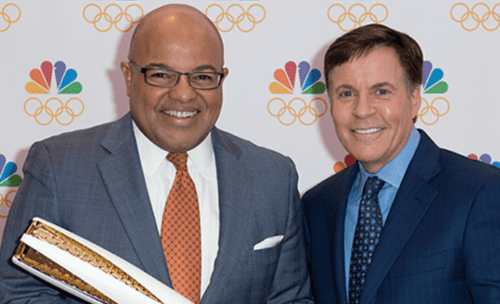Barstool Sports dug up this 1991 story about Mike Tirico, the NBC sports announcer who has inherited Bob Costas’s job as anchorman of the Olympics:
Hold The Phone – Mike Tirico Isn’t Black?
Post-Standard, The (Syracuse, NY)
May 30, 1991
Local African-American groups often invite him to speak during Black History Month and on other occasions, viewing Tirico as a prominent example of a successful black professional. He doesn’t mind speaking, Tirico tells them, but he also lets them know a fact of his life: He’s not sure he’s black. “When people go around and say, ‘You are black’ – well, I don’t encourage it, but by the same token I don’t back off of it,” he says. “If you want to call me that, that’s fine. But, you know, in my whole family, there’s nobody I know who is black.”
Raised in Queens Michael Todd Tirico grew up in a middle-class Italian family in Queens, about a five-minute drive from Shea Stadium. Tirico’s parents, Donald and Maria, were separated when he was about 4, and he says he has since lost contact with his father’s side of the family.
Tirico is an only child. Because of his dark skin and ethnic features, Tirico says, most people assume he is black. But he’s seen pictures of his father, his father’s mother and his father’s sister – all of whom are white, Tirico says. “The only contact I had growing up was with my mom’s side of the family. And they are all as white as the refrigerator I’m standing in front of right now,” Tirico says … Someday, he says, he plans to do genealogical research to find out if he has a black ancestor, but it’s not something he considers a pressing issue.
It’s easy to come up with theories, like maybe your mom hasn’t been wholly frank about why her husband walked out. Lots of families have secrets. For example, it’s not wholly rare for people of a certain age to find out that their big sister who is 17 or so years older than them is really their mom (e.g., Jack Nicholson, Bobby Darin).
But let’s look at Mike Tirico instead as an example of how rare it is in modern non-Hispanic America for somebody who appears to be kind of black not to claim to be black. I won’t call him “the exception that proves the rule” because that always triggers a lot of people, such as a certain federal judge, who want to explain that, logically, an exception can’t prove a rule. So I will call Tirico an example of somebody whose famous exceptionalness to the general tendency offers support for the tendency.
The tendency is that people who are significantly black by ancestry seldom self-identify as white in recent decades (assuming they aren’t from some culture like Latin America where that is encouraged). This in contradiction to the popular theory of White Privilege.
Some of that is for Flight From White reasons, but another big reason is that there just aren’t that many people in Anglo-America who are kinda, sorta black enough to go either way, due to the workings of the One Drop Rule. As I blogged in 2014:
The 23andMe numbers suggest that for the average white American, 1 of your 512 ancestors nine generations ago was black and 1 of 512 was Native American.
Here’s another way to think of it. If the average self-identified black is 73.2% black and the average self-identified white is 0.19% black, then the average black in America is 385 times blacker than the average white.
A commenter adds:
And here is another way of thinking about it: The average white American is about ten times more Neanderthal than Sub-Saharan black.
Africans have virtually no Neanderthal ancestry so African-American Neanderthal ancestry is, on average, in proportion to their white ancestry.
[Comment at Unz.com]
.













